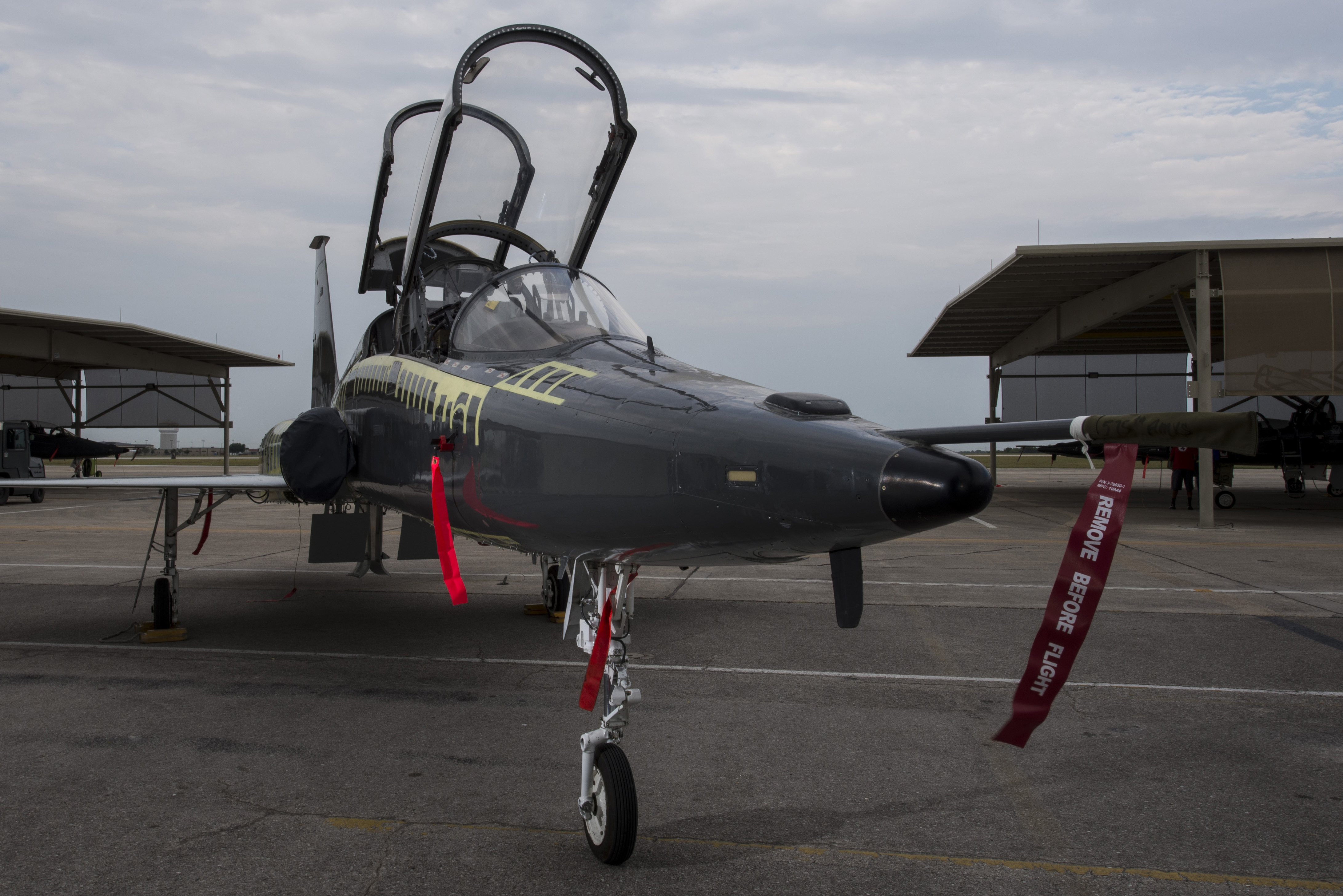A T-38 Talon on the ramp at JBSA-Randolph, Texas. Air Force photo by A1C Stormy Archer.
Just days after its CEO hinted strongly that it might drop out of the Air Force’s $13 billion T-X trainer program, Northrop Grumman did just that. In a terse statement issued Wednesday with partner BAE Systems, Northrop Grumman said that, after reviewing the Air Force’s T-X requirements and acquisition strategy as contained in the final request for proposals, issued Dec. 30, the companies have “decided not to submit a proposal … as it would not be in the best interest of the companies and their shareholders.”
Northrop CEO Wes Bush, in a fourth-quarter earnings call with analysts last week, said the company was applying “discipline” on the T-X, making sure there’s a “business case” for the work and not simply going ahead with a bid just because it has invested money in the project. Northrop wanted to make sure “we’re not kidding ourselves about the real cost and what the investment would look like.”
Bush’s remarks were prompted by an analyst asking whether the T-X was being structured as a “cost shootout,” and he responded that when cost, rather than best overall value, is the customer’s primary focus and there’s “not a whole lot of differentiation” between the products being offered, the company sees those “opportunities” as “less interesting.” Northrop’s Scaled Composites subsidiary built a flying prototype T-X, but the company has not said how much it has invested in the project, although Bush said the work done has “broader applicability” than just the T-X contest.
Northrop officials did not respond to calls and it’s not clear if that “broader applicability” means the aircraft might still be offered in other world trainer competitions.
Unlike T-X competitors Lockheed Martin, Boeing/Saab, and Raytheon/Leonardo, Northrop never made a splashy media reveal of its T-X design, and the only pictures of it were snapped by passersby at Mojave airport, Calif., where Scaled is based and where the jet underwent taxi and flight tests. The jet bore a passing resemblance to the T-38—designed by Northrop—which the T-X is meant to replace, technically making the company the “incumbent” in the contest.
Raytheon and Leonardo, which were offering the T-100 jet—a version of Leonardo’s M-346 Master—also quit the T-X competition last week, and industry sources said it was because the companies couldn’t agree on how to get their bid to a cost level Raytheon considered competitive.
The exit of Northrop and Raytheon sets up Boeing/Saab and Lockheed Martin/Korean Aerospace Industries as the heavyweights in the T-X competition, each having taken a different approach to their offerings.
Boeing and partner Saab purpose-designed a new airplane for T-X, which Boeing leaders said was shaped by a strict adherence to the Air Force’s requirements—with little excess capability—and use of existing elements wherever possible, to reduce cost and risk. Lockheed Martin explored a “clean sheet” design as well, but wound up modifying the T-50 trainer it helped KAI design and build for the Korean market. It’s banking on the existence of a warm supply chain, a proven design that closely matches USAF’s needs, and low risk as its discriminators.
In fact, one Lockheed official said, while the T-50 (the T-X competitor is called the T-50A) was designed in the 1990s for the Korean market, it was assumed at the time that the Air Force would soon pursue a T-38 replacement, and the T-50 would be ready to go when that program got underway. No one at the time expected it would take the Air Force another 15 years to launch the T-38 replacement program.
Textron is said to be considering a bid with a variant of its Scorpion privately-developed airplane, and Sierra Nevada/Turkish Aerospace is also expected to be making a bid. Leonardo has not said whether it will offer the T-100 on its own.
The sharp narrowing of the field of T-X competitors is almost exactly the opposite of what the Air Force attempted to accomplish in structuring the contest, which was meant to draw as many entrants as possible. Throughout the development of requirements, there were continuous engagements with industry to make sure there were no arbitrarily set specifications that might inadvertently disqualify any likely offerors, and some of those were relaxed to permit broader participation.
The Air Force offered a comment on Northrop’s withdrawal, saying the service “continues to believe there will be a robust competition for the Advanced Pilot Trainer, a.k.a. T-X, and continues to look forward to the results of the ongoing source selection.”
The company’s decision not to bid on T-X is not without precedent. After the Northrop/EADS team won the KC-X tanker competition—and that win was thrown out after a protest by Boeing—Northrop opted not to compete in the re-run of the contest, saying the rules had been restructured to favor Boeing’s entry. Airbus bid on its own with the same KC-45 platform and lost to Boeing, which is now building the KC-46.
In the late 1980s, Northrop—partnered with Grumman, which was a separate company at the time—was selected as a finalist against General Dynamics and McDonnell Douglas for the A-12 stealth attack plane. When the terms of the fixed-price development contract were revealed to the companies, Northrop chose not to bid because the project’s true costs and company liability were unpredictable. The Navy chose the GD/McDonnell team by default, but the secret program quickly ran way over budget and behind schedule, prompting then-Defense Secretary Dick Cheney to terminate the jet. His action prompted a legal case—which persisted for 23 years and twice came before the Supreme Court—over whether the Navy or the contractors were at fault in the A-12 debacle. The experience? led the Pentagon to avoid fixed-price development programs in the future.
For more on the T-X, read: Building Better Pilots, Considerations to Ensure T-X Success, from AFA’s Mitchell Institute.
